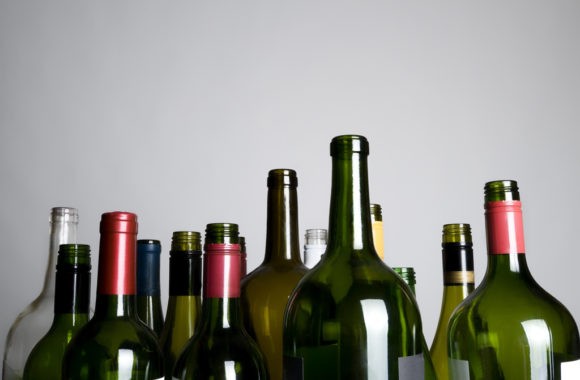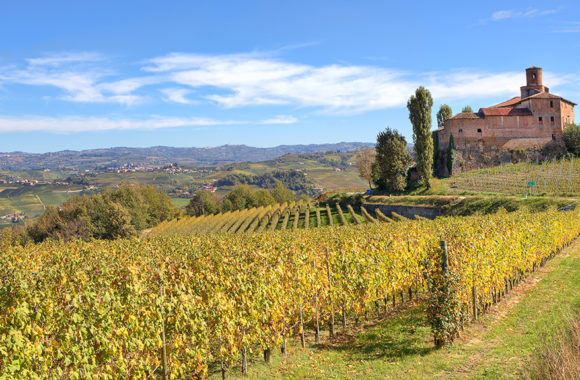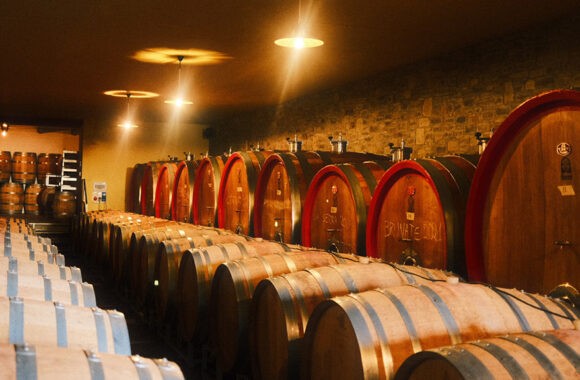
An Introduction To: Washington
· Maggie Macpherson Maggie Macpherson on
Jeroboams Education is a new series on our blog providing you with the lowdown on the most iconic wine producing regions of the world. Led by our super buying team, Peter Mitchell MW and Maggie MacPherson will introduce you to the key facts and a little history of all the regions you recognise but perhaps don’t know too well. To help really further your education, why not drink along?
Introduction
Washington state is beautiful: it boasts wonderful coastlines, rugged mountains, desert scenes and of course, Twilight. No, I’m not talking about the time of day between daylight and darkness but of the phenomenally successful book and film franchise revolving around a group of ridiculously good looking Vampires and Werewolves which was based in Forks, a small town in Washington famed for being one of the rainiest areas in the US. Don’t let this wet notoriety put you off Washington wines though; Forks is based on the northern coast of Washington, while most wines are produced inland east of the cascade mountain range and erring into almost desert like climates. Sadly, Washington state is often overlooked, which is mad given Washington ranks second in the US for premium wine production and there are over 59,000 acres planted to vinifera grapes. That being said, I guess we can be forgiven for overlooking Washington state given that over 40% of these vines have only been planted in the last 10 years…
History
Washington’s first grapes were planted at Fort Vancouver by the Hudson’s Bay Company in 1825. By 1910, wine grapes were growing in many areas of the state, following the path of early settlers. French, German and Italian immigrants pioneered the earliest plantings. It started with hybrid varieties which arrived in the Puget Sound region as early as 1854, and by 1860 were planted in the Walla Walla Valley. Large-scale irrigation, essential to most of Washington’s vineyards today was introduced in Eastern Washington in 1903, using runoff from the melting snow caps of the Cascade Mountains. In the early part of the 20th century Italian and German varietals were planted in the Yakima and Columbia Valleys expanding plantings dramatically. However, as with all of US wine regions, the arrival of Prohibition in 1920 put a damper on production, however by 1938 there were 42 wineries located throughout the state. These were mostly small family owned wineries, and commercial-scale planting didn’t arrive in Washington until the 1960s, with Chateau Ste. Michelle at the forefront. Chateau Ste. Michelle is still operating, and its first wine, a Cabernet Sauvignon from Yakima Valley, is still considered the state’s flagship wine and they now recognised one of the world’s leading Riesling producers, having received “Winery of the Year” more than 20 times from Wine & Spirits Magazine. It’s fair to say that we’re really only at the beginning of Washington’s wine story.
Grape Varieties
There are approximately 70 varieties grown in Washington, with a ratio of about 59% red and 41% white. The best-known varieties thriving in Washington are Riesling, Cabernet Sauvignon, Merlot and Syrah.
Climate & Soil
Much of eastern Washington could be considered a desert, however the growing season is shorter than more southerly wine regions. But it is the number of sun hours received in Washington with its incredibly long days during the growing season (up to 16 hours during high summer) that allow it to successfully ripen varieties that usually prefer a long growing season, this and the fact it receives on average 300 days of sunshine per year. It also has an incredibly dry growing season with the Olympic and Cascade Mountain ranges in the Western portion of the state combining to stop the clouds rolling in off of the Pacific Ocean – known as a Rain Shadow Effect. Only 7 to 12 inches of rain fall in Eastern Washington during the growing season, and 35 to 38 inches in Western Washington (hence Forks being famous for rain). Due to its arid climate, Eastern Washington is remarkably fungus free allowing for producers to embrace sustainable vineyard practices. Another benefit of this desert like climate is the diurnal temperature change. Washington State has some of the most dramatic fluctuations of any wine region in the world allowing grapes to retain acid in this warm climate. Unlike other dry regions, Washington has plentiful water resources to rely on for irrigation. A benefit of irrigation is that it allows for absolute control as to when the vine is given moisture and how much is given, which contributes to grape ripeness, lack of sugar dilution, canopy management and dehydration controls at vital moments during its growth.
The relationship to the Missoula Floods, a series of cataclysmic events, defines the soil types of the vineyards in Washington. Most vineyards lie below the floodwaters with soils of loess—wind-blown deposits of sand and silt – overlying gravel and slackwater sediment with basalt forming the bedrock. This provides a diversity of soil types that are well drained and ideal for viticulture.
The Sub-regions of Washington
Columbia Gorge AVA
Columbia Gorge was established in 2004 and named after an 80-mile long gorge the Columbia River carved into basalt bedrock. The area straddles the Columbia River, with part of the growing region extending into Oregon and is one of Washington’s only growing regions that lies outside of the Columbia Valley appellation. Due to relatively cool temperatures in some areas of the appellation, the Columbia Gorge is one of only three growing regions in Washington where white grape plantings outnumber red grape plantings (Yakima Valley and Ancient Lakes are the others). White wines from this region are known for their crisp acidity. Chardonnay, Gewürztraminer, and Pinot Gris are the most planted varieties. Driving west to east, annual rainfall decreases approximately one inch per mile. As a result, western vineyards have more of a maritime climate, ideal for cool climate grapes; eastern vineyards have a continental climate, better suited to warm weather varieties. Additionally, some western vineyards do not use irrigation, an extreme rarity in eastern Washington. Proximity to the Columbia River helps guard against frost, which can be a problem in nearby areas. Climatically, the Columbia Gorge is also notable for its near-constant winds.
Puget Sound AVA
The Puget Sound appellation is located in north-western Washington and is Washington’s only growing region located west of the Cascade Mountain range. It has a temperate, maritime climate, unusual for Washington wine regions and is therefore Washington’s coolest and wettest growing region. Cool climate grapes dominate in this area, with Pinot Noir the most planted variety followed by Riesling. Summers are typically warm and dry, but abundant rainfall in winter means that most vineyards in this area can dry farm, in contrast to eastern Washington where irrigation is required due to the desert climate.
Columbia Valley AVA
Established in 1984, Columbia Valley is Washington’s largest region encompassing more than a third of the state and is shared with Oregon. The Columbia Valley is home to over 99% of all of Washington’s vinifera acreage. Cabernet Sauvignon is the most planted grape followed by Merlot, Chardonnay, Riesling, and Syrah. However, over 30 vinifera varieties are currently planted in this region. The Columbia Valley lies in the rain shadow of the Cascade Mountain range. The region has an arid and semi-arid, continental climate therefore irrigation is often used. This irrigation, along with consistently warm, dry temperatures during the growing season, provides growers with a large amount of control over grape development compared to many other regions of the world, this leads to minimal vintage variation. Early and late season frosts along with hard winter freezes are the main environmental threats. Due to dry temperatures and sandy soils, phyloxera has not yet established itself in the area, so most vines are grown on their own rootstock. Most of Washington’s growing regions are sub-appellations of the Columbia Valley.
Ancient Lakes AVA
Established in 2012 and located in central Washington, it is wholly contained within the Columbia Valley region and is named after a series of thirty-five lakes that dot the area. It is one of the few growing regions in the state where white grapes are more predominant than red. Riesling is by far the most planted variety displaying aromas and flavours of lime, lemon, and green apple and bright acidity. It is an arid, continental climate, receiving an average of 6 inches (15cm) of rainfall annually therefore irrigation is widely used. As one of the more northerly regions it has a shorter growing season and is one of the cooler growing regions in the state. Soils vary considerably across the appellation, fine sand along with silt and sandy loam are predominant. The Columbia River, which defines the western boundary, protects much of the region from early and late season frost.
Horse Heaven Hills AVA
The Horse Heaven Hills takes its name from an early pioneer who said, upon seeing the region and its wide prairies and expanses, ‘‘Surely this is Horse Heaven!” As one of the regions warmer growing areas it is primarily planted to red varieties, particularly Cabernet Sauvignon and Merlot, whiles whites are dominated by Chardonnay and Riesling. There are three main soil types in the area—wind-blown sand and loess, Missoula Flood sediment, and hill slope rubble from the Columbia River basalt bedrock. Like most of Columbia Valley it has an arid and semi-arid, continental climate meaning irrigation is common. Significant winds effect the area reducing canopy size and toughening grape skins, as well as protecting against mould and rot. The nearby Columbia River also has a moderating effect on temperatures, reducing the risk of early and late season frosts.
Lake Chelan AVA
The Lake Chelan is about 112 miles east-northeast of the city of Seattle. The most planted grapes are Pinot Noir and Riesling, followed by Syrah. Climatically, the area is defined by Lake Chelan, with vineyards located along the southern and eastern portions of the lake. The lake moderates temperatures providing cooler summer days and warmer summer nights compared to other regions. As a growing region, the Lake Chelan appellation is unique from others in eastern Washington in that it lies north of the Missoula Floods. Soil types here are glacial sediments along with ash and pumice from volcanoes from the nearby Cascade Range.
Lewis-Clark Valley AVA
Formed by the Snake and Clearwater rivers, the Lewis-Clark Valley AVA consists of canyon side and bench lands and about 72% of the Lewis-Clark Valley AVA is located in Idaho. Known as the “banana belt,” due to its temperate climate producing high quality fruit trees such as peaches, apples, wine and table grapes. Currently, the Lewis-Clark Valley AVA is home to only 16 vineyards.
Naches Heights AVA
Naches Heights is northwest of the city of Yakima. Established in 2011, all the vineyards are farmed either organically, biodynamically, or salmon-safe, with some a combination. A million-year-old lava flow formed the region, which is considerably higher than the surrounding regions, with elevations ranging from 1,200 to 2,100 feet.
Yakima Valley AVA
Yakima Valley was approved in 1983 and is the state’s oldest federally recognized growing region and is a sub-appellation of the Columbia Valley. As one of Washington’s cooler growing regions white grape plantings outnumber red grape plantings. Chardonnay is by far the most planted grape in this region followed by Riesling. In fact, the Yakima Valley is home to almost half of all Chardonnay and Riesling plantings in Washington. The Yakima Valley has an arid and semi-arid, continental climate so irrigation is common. While generally a cooler region, the Yakima Valley also includes the Red Mountain appellation, which is consistently one of Washington’s warmest growing regions. In fact, the Yakima Valley wholly contains the sub-appellations Rattlesnake Hills, Red Mountain, and Snipes Mountain.
Rattlesnake Hills AVA
Rattlesnake Hills is a sub-appellation of the Yakima Valley, and the hills are named after the Northern Pacific Rattlesnake, which inhabits the area. Riesling is the most planted grape followed by Merlot and Cabernet Sauvignon. The appellation itself lies on the south slope of the Rattlesnake Hills and includes the highest point in the Yakima Valley AVA. The appellation’s heightened elevation lessens the risk of spring and fall frosts. It has an arid, continental climate and irrigation is therefore required to grow vinifera grapes.
Red Mountain AVA
Red Mountain is the smallest appellation in Washington State and due to warm temperatures, red grape varieties dominate on Red Mountain. Its name is somewhat of a misnomer as it is neither red nor mountainous, with elevations ranging from 500ft to 1,500ft. The nearby Yakima River moderates’ temperatures and provides continual airflow, guarding against frost. A lack of soil nutrients along with the high pH reduces the vigour of the vines, resulting in significantly smaller berry sizes.
Snipes Mountain AVA
Named after Ben Snipes, a cattle rancher who built a house there in the 1850s. Chardonnay and Cabernet Sauvignon are the most planted varieties. Steep north and south-facing slopes allow cold air to flow downhill, preventing frost damage. A large percentage of soils are classified as Aridisols, which are low in organic matter. This is believed to reduce vigour in the vines and increase fruit concentration. Though the area only received appellation status in 2009, Snipes Mountain boasts a long viticultural history with Muscat of Alexandria vines from 1917 still producing.
Wahluke Slope AVA
The Wahluke Slope, named after a Native American word for “watering place,” lies in south-central Washington. The area is geographically isolated, bordered by the Columbia River, Saddle Mountains, and Hanford Reach National Monument. As one of the warmest regions in the state, the Wahluke Slope is known primarily for red grape varieties, particularly Cabernet Sauvignon, Merlot, and Syrah. The major distinguishing feature of the Wahluke Slope is its uniformity in aspect, soil type, and climate. As with most of Washington irrigation is required to grow vinifera grapes. However, winds in the area lead to smaller leaf size and smaller grape clusters compared to other regions.
Walla Walla Valley AVA
Walla Walla Valley is another AVA which is shared with Oregon. The growing region is wholly contained within the Columbia Valley and is named after a Native American term for “many waters.” The Walla Walla Valley has boomed in the last fifteen years and has the highest concentration of wineries in Washington. Grape production is dominated by red varieties. The area is cooler and wetter than several of Washington’s growing regions which allows a limited number of vineyards in the eastern section to dry farm—an extreme rarity in Washington. Most soils are well-drained, sandy loess over Missoula Flood slackwater deposits and fractured basalt. However, an ancient cobblestone riverbed defines the area to the south. These cobblestones absorb the sun’s heat, radiating it to the roots and grape clusters.
Market
As previously discussed, Washington is only second to California in volume of premium wine produced in the US. The domestic market is undoubtedly its most important market, however it might be surprising to hear that the UK is improving as an export market. Exports to the UK have increased 37% in five years, up from $1.4m in 2015 to $1.9m in 2019. Other notable export markets are the Nordics which embraced the value for money premium wines of Washington far earlier than the UK.
Recent Vintages
2007 – Ideal spring temperatures followed by a fickle summer, cool but with huge heat spikes. However, a sunny and dry autumn allowed for ripeness all round with Cabernet, Merlot, Riesling and Syrah fairing particularly well.
2008 – Rain during spring, and a cooler summer extended the growing season. Fruit flavours less ripe with higher acid levels. Good potential for aging.
2009 – A poor fruit set reducing yields and a hot summer results in wines with high alcohol with lots of tannic structure.
2010 – An unusually cool summer produced dramatic differences in ripening between warmer and cooler sites. A vintage producing elegant balanced wines with lower alcohol and higher acidity.
2011 – Late frosts damaged vines in Horse Heaven Hills and Walla Walla AVAs, followed by a cool summer resulted in latest harvest on record. White wines are looking particularly good from this vintage.
2012 – Warm, sunny and consistent weather finally! A stellar vintage all round, with natural high acidity and plush ripe flavours.
2013 – Above average temperatures during this warm vintage, particularly during the night, reducing natural acidity.
2014 – Another warm and long growing season, volumes are up, along with alcohols.
2015 – Hot, hot, hot. The warmest vintage to date in fact creating the earliest harvest on record in order to control sugars.
2016 – An early and warm vintage but cooler weather in June continued through to September. Expect wines of balance and moderate alcohol.







